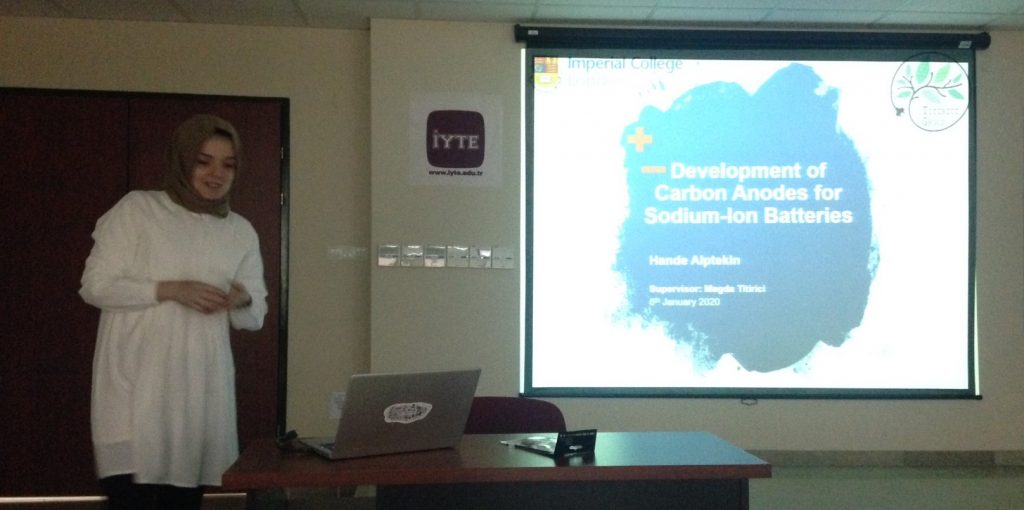Seminar / Hande Alptekin / SODIUM STORAGE MECHANISM INVESTIGATIONS THROUGH STRUCTURAL CHANGES IN HARD CARBON ANODES

Hande Alptekin, a PhD student in Chemical Engineering at Imperial College London has visited IZTECH and has given a speech. The abstract of the speech is as follows.
SODIUM STORAGE MECHANISM INVESTIGATIONS THROUGH STRUCTURAL CHANGES IN HARD CARBON ANODES
Hande Alptekin1, Heather Au1, Anders Jensen2, Alan Drew 2, Magdalena Titirici1
1 Department of Chemical Engineering, Imperial College London, London SW7 2AZ, UK
2 School of Physics and Astronomy and Materials Science and Materials Research Institute, Queen Mary University of London, London E14 NS, UK
Abstract:
Inexpensive, efficient energy storage systems are essential for the wide-scale successful implementation of renewable energy technologies. Among the various available energy storage technologies, Li-ion batteries (LIB) have been have received considerable attention. However, in terms of largescale application they are not suitable because their price is very high, which is resulting from the uneven distribution of lithium reserve around the world and increasing consumption. Hence, it is crucial to research low-cost secondary batteries for energy storage technologies. Sodium is located below Li in the periodic table, so it possesses similar chemical and physical properties to Li in many aspects. First of all, regarding availability sodium is fourth most abundant element in the Earth’s crust, making sodium relatively inexpensive. [1-6] Namely, sodium-based batteries could provide an alternative chemistry to lithium batteries and might become competitive to lithium-ion batteries. However, there are still inevitable drawbacks related to discovery of suitable anode materials. Optimizing the porous and graphitic structure of the anode materials is important to achieve electrochemically elevated Na-ion battery technology. In this study, we will present the preparation of a series of hard carbon anode materials prepared via the Hydrothermal Carbonisation (HTC) followed by high temperature carbonisation. Applying various carbon precursors, carbonization temperatures, templating agents and dopants results in materials with different pore morphologies, functional groups and graphitisation degrees which were characterised by HRTEM, XPS, Raman, SAXS/WAXS and total neutron scattering. By tuning the degree of graphitic regions to disordered domains, capacity obtained from slope and plateau regions of the discharge curve adjusted and an optimal irreversible capacity up to 300 mAh/g were achieved. The influence of material morphology, type of the dopant and microstructural change on electrochemical performance and Na-storage mechanism were investigated by Galvanostatic Intermittent Titration Technique (GITT) and Electrochemical Dilatometry. In conclusion, we studied the effect of the carbonisation temperature on the storage mechanism and electrochemical performance of hard carbons obtained via HTC of glucose with citric acid. The Na storage mechanism can be correlated with the pore structure and degree of graphitisation.
References
1.Ponrouch, A. et al. Non-aqueous electrolytes for sodium-ion batteries. J. Mater. Chem. A 3, 22–42 (2015).
2.Barpanda, P., Oyama, G., Nishimura, S., Chung, S.-C. & Yamada, A. A 3.8-V earth-abundant sodium battery electrode. Nat. Commun. 5, 4358 (2014).
3.Zhou, G. et al. Graphene-Wrapped Fe 3 O 4 Anode Material with Improved Reversible Capacity and Cyclic Stability for Lithium Ion Batteries. Chem. Mater. 22, 5306–5313 (2010).
4.Lu, L., Han, X., Li, J., Hua, J. & Ouyang, M. A review on the key issues for lithium-ion battery management in electric vehicles. J. Power Sources 226, 272–288 (2013).
5.Li, L. et al. Recent progress on sodium ion batteries: potential high-performance anodes. Energy Environ. Sci. 11, 2310–2340 (2018).
6.Li, Y., Hu, Y. S., Titirici, M. M., Chen, L. & Huang, X. Hard Carbon Microtubes Made from Renewable Cotton as High- Performance Anode Material for Sodium‐Ion Batteries.” Advanced Energy Materials 6.18 (2016)
Short Bio:
Hande is a PhD student in Chemical Engineering at Imperial College London. Her research focuses on Sodium storage mechanism investigations through structural changes in hard carbon anodes using in-operando techniques in sodium-based battery systems, under the supervision of Prof. Maria Magdalena Titirici. Hande is a Chemical Engineer and received her education at Ege University, Turkey. After graduation in 2013, she then joined the Material Science and Engineering department at the Izmir Katip Celebi University, Turkey. Beside her research, Hande is also a Student Programme Leader at the Imperial College London Graduate School for Research Impact and Influence to co-commission the programme and to the co-design courses. She has been running and volunteering STEM workshops as a STEM Ambassador to engage young people with science, technology, engineering and mathematics.
